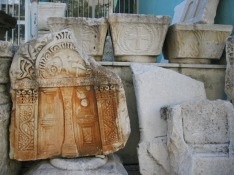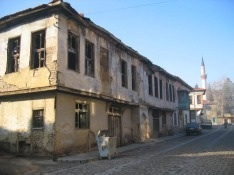“Groom” Town Population: 229,500
Back in the 16th and 17th centuries Uşak in Western Anatolia was a town known for making stupendous carpets – you can see some magnificent examples in the Museum of Turkish and Islamic Arts and the Carpet Museum (currently closed) in İstanbul. Today it’s a thoroughly modern place with unusually well-laid streets and pavements. In this rather unlikely setting you will stumble upon one of Turkey’s richest museums which houses the Kanun Treasure, a fantastic horde of silver and gold supposedly named after an especially wealthy individual mentioned in the Koran.
Around Güre village in the valley of the Gediz River, 25km west of Uşak, ancient burial mounds cover the remains of some of the Lydian kings who ruled this area in the 6th century BC. In 1960s grave robbers hacked into the İkiztepe, Toptepe and Aktepe mounds and uncovered a treasure trove of more than 400 gold, silver and glass artefacts. Most of these items found their way to the United States where they were put on display at New York’s Metropolitan Museum of Art. After a long legal battle they were finally returned to Turkey in 1993 and put on display in the old Uşak Museum . Then in 2006 there was an outcry when an anonymous tip-off revealed that a fake had been substituted for a lovely gold brooch.
It’s well worth going out of your way to see the collection, which includes some elegant silver bowls, a silver jug with the tiny figure of a naked acrobat forming a handle, and some very Egyptian-looking jewellery.
Just as wonderful are the remains of wall paintings depicting a young woman in a long scarf and red robe, and a young man and woman facing each other, their long almond-shaped eyes harking back to Egyptian prototypes. Other wall paintings are thought to have been destroyed by the grave robbers.
 The collection is now on display in a purpose-designed new Archaeology Museum with a whole floor devoted to the Kanun Treasure. It’s right next to the train station (Closed Mondays, €3, 2024).
The collection is now on display in a purpose-designed new Archaeology Museum with a whole floor devoted to the Kanun Treasure. It’s right next to the train station (Closed Mondays, €3, 2024).
The town centre is dominated by an enormous monument to Atatürk designed by Tankut Öktem in 2001. Leaping out at the front are three equestrian statues of the great man while, at the back, peasants manhandle a huge wooden cart. Above all this rampant activity, a calm civilian Atatürk stands between male and female figures symbolising art and science. Only Kastamonu has anything comparable.
Cumhuriyet Caddesi, Uşak’s partially pedestrianised high street, continues north from the statue to Cumhuriyet Meydanı where two mosques, the Ulu Cami and the Burmalı Cami, stand virtually side by side. The Burmalı Cami (1570) boasts a wonderful fluted brick minaret while the Ulu Cami (1406) has a 19th-century narthex, with a sequence of plastered domes.
The back streets are full of crumbling Ottoman houses that are now being restored. One of them, the Latife Hanım Evi, has been converted into a cultural centre. Even more beautiful is the Tekeşoğlu Hacı Abdülkadir Konaği.
Near the Ulu Cami there are also remains of a couple of hans. The early 20th-century Bedesten is now full of jewellery shops. The Sarraflar Çarşısı (Jewellery Market), a stylish old shopping arcade would, with careful investment, be as splendid as anything in London or Paris.
The Kent Tarihi Müzesi (City History Museum, closed Mondays) can also be visited near the Burmalı Cami. North of the Archaeology Museum on Hisarkapı Uluyolu Sokak an Atatürk and Ethnography Museum is housed in a late 19th-century house where Atatürk spent a night in 1922 (open daily, free).
Just east of Uşak a sign reading ‘abideler’ leads to the monuments to commemorate the 1922 Battle of Dumlupınar that marked a turning point in the Turkish War of Independence.
Sleeping
Ağaoğlu Hotel. Tel: 0276-223 3814
Nest Hotel. Tel: 0276-224 5711
Transport info
Regular buses from İzmir to Uşak pass through Kula. From Uşak buses also run to Afyon and Konya.
You can easily get to Uşak by train from İzmir’s Alsancak station too.
Day trip destinations


